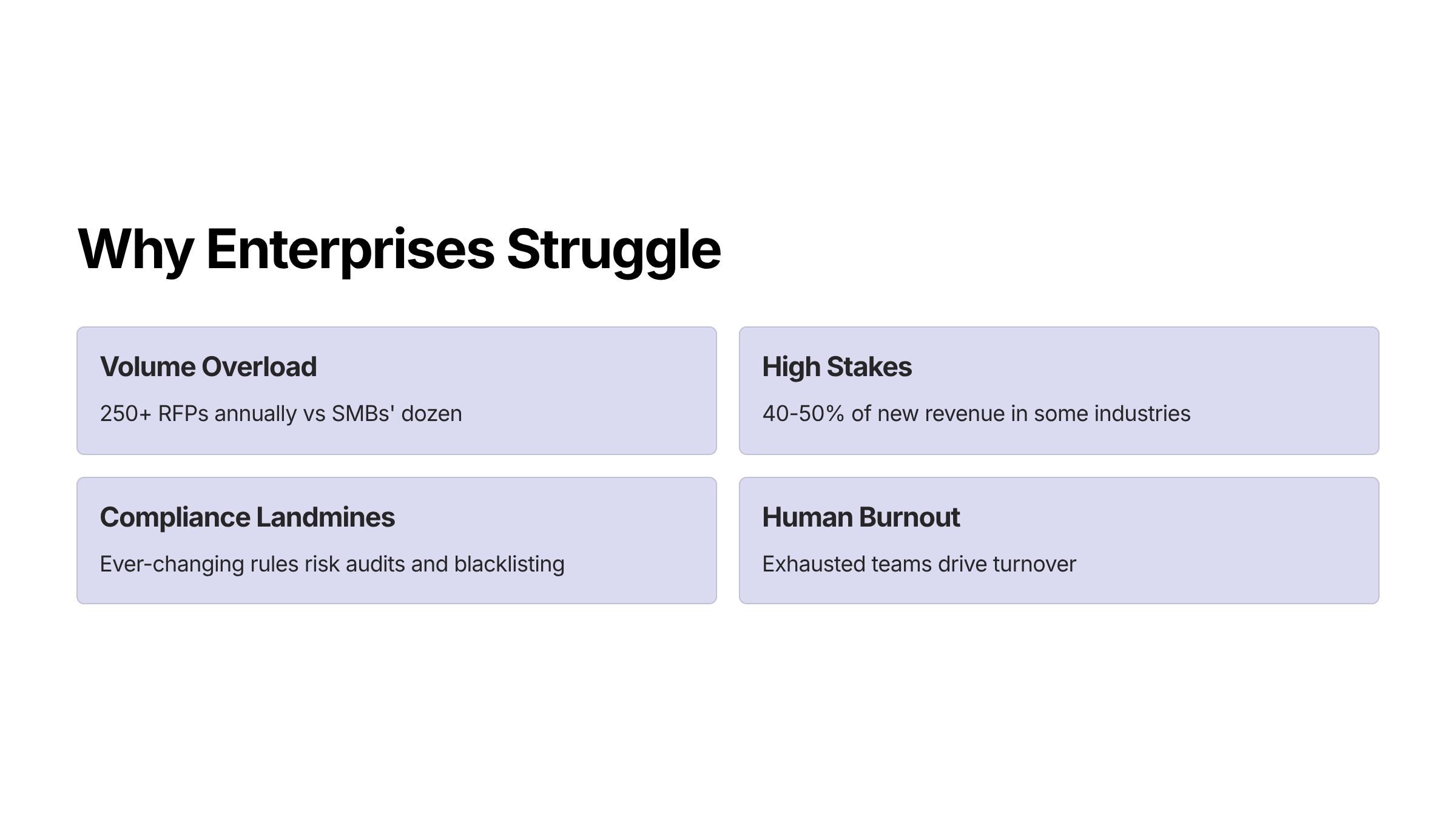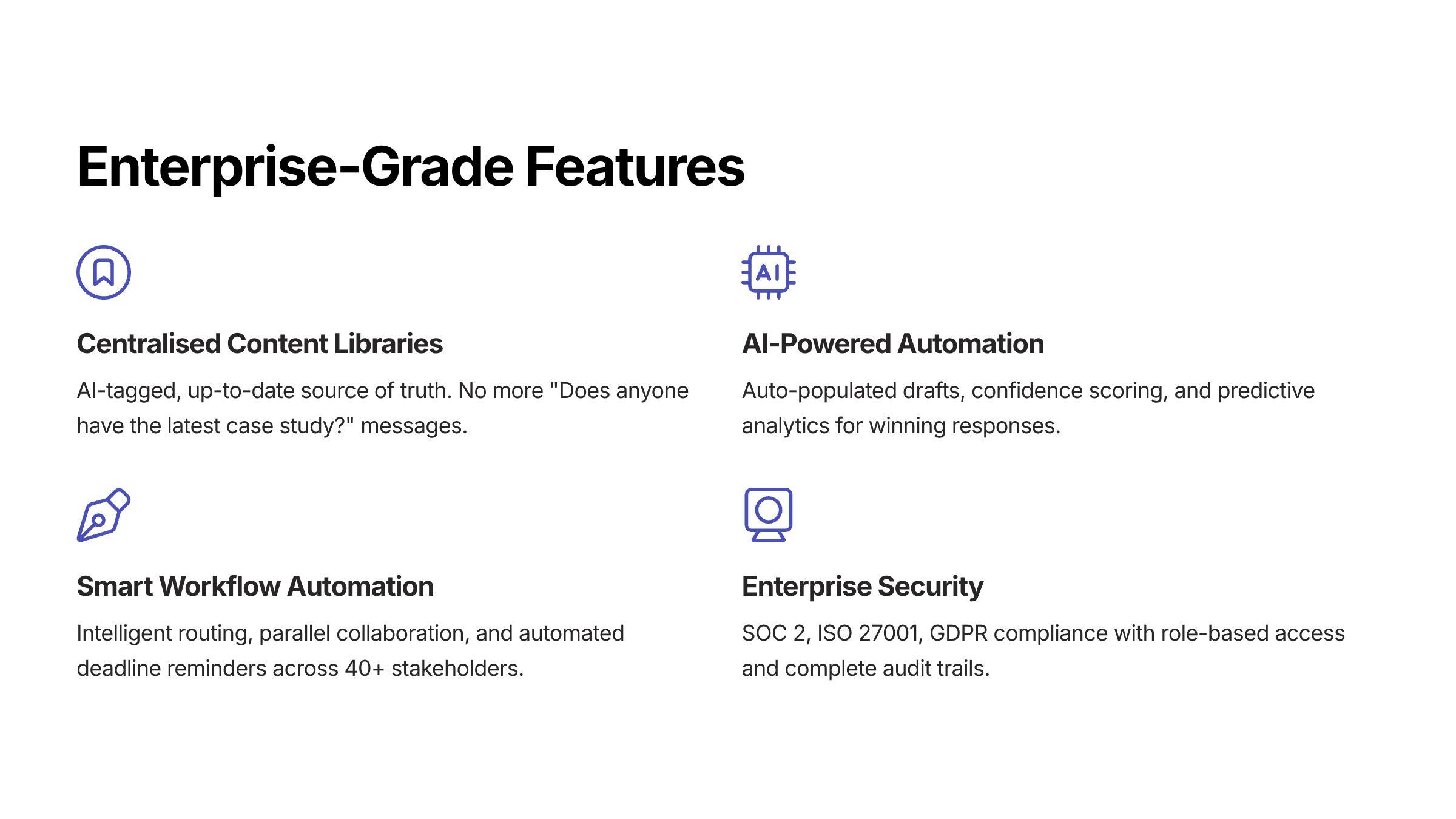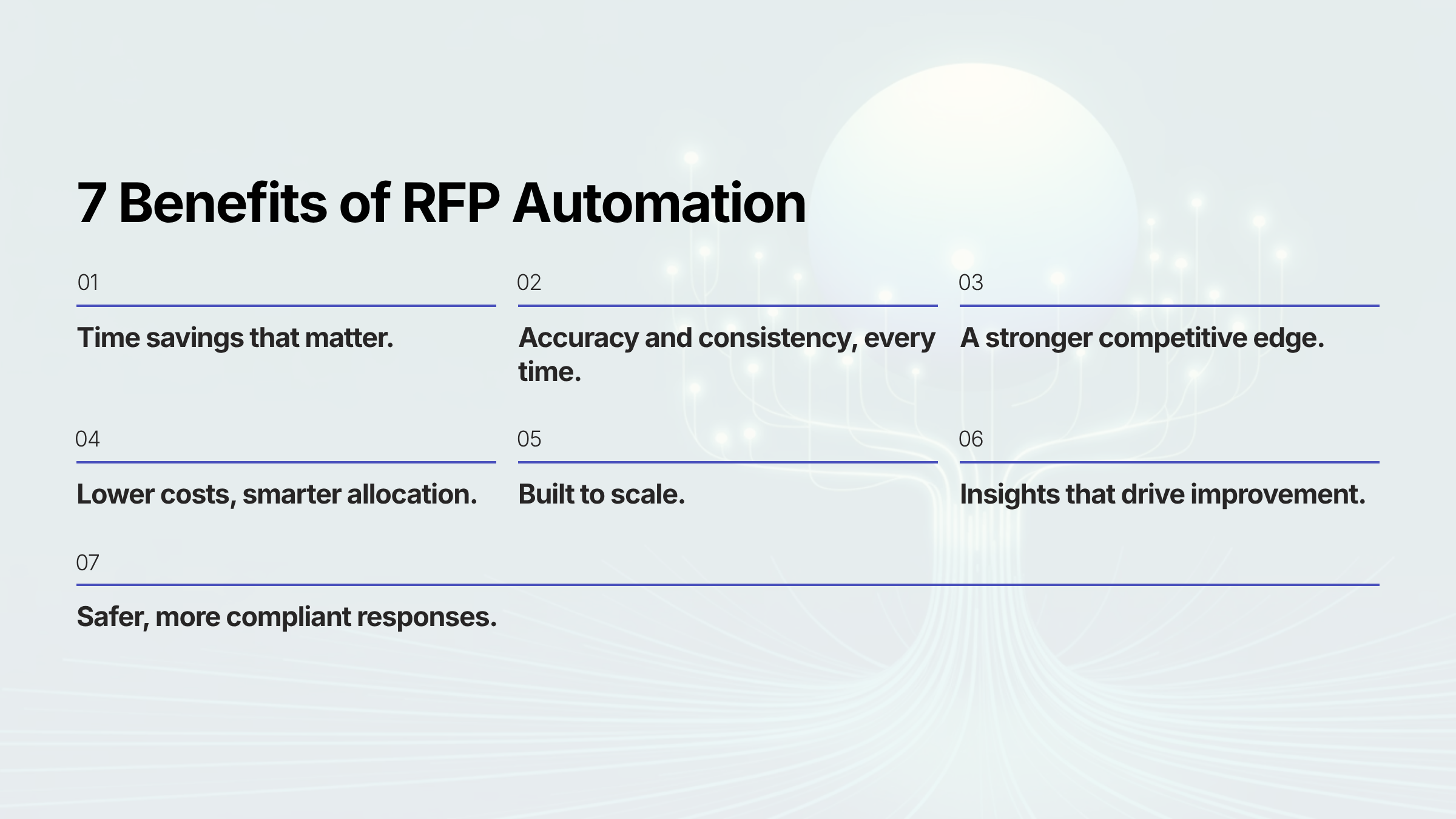RFP Software for Enterprises: The 2025 Playbook for Smarter, Faster, and Winning Proposals
Article written by
Kate Williams

INSIDE THE ARTICLE
SHARE THIS ARTICLE
Summary
Enterprise RFP software solves what spreadsheets can’t—scaling content, workflows, and compliance across global teams. This guide unpacks how large companies standardize RFPs, increase win rates, and unlock millions in pipeline revenue using intelligent tools built for complexity. If you’re still coordinating via Excel and email, you’re already falling behind.
If an AI-product-based company juggles their RFPs with spreadsheets, email threads, and random files on SharePoint, then what's the point of building an AI product, right? RFPs are massive revenue engines. In many enterprises, they influence a third or more of all revenue. Lose your grip on them, and you’re bleeding pipeline without even realizing it. That’s why AI-powered RFP software for enterprises has moved from the back row to the front row of the SaaS ecosystem sooner than expected. It jotted down the difference between chasing deadlines and consistently winning complex, high-value deals.
In this blog, let's get into the depth of RFP software built for enterprises, why they are in demand, and what are the additional benefits of automating your RFP process.
What Is RFP Software for Enterprises?
Think of RFP software as the operating system for managing proposals at scale. At a basic level, it automates repetitive work, stores reusable content, and helps teams collaborate without stepping on each other’s toes.
But in an enterprise context, it goes deeper:
- Procurement leaders get consistency and transparency across every vendor evaluation.
- Sales and bid teams stop hunting for old Word docs and start pulling from centralized, approved content libraries.
- Executives finally see the big picture—how fast the company is responding, whether teams are compliant, and what percentage of bids they’re actually winning.
This isn’t about making proposals prettier. It’s about turning RFPs into a scalable, auditable, and revenue-driving process that doesn’t collapse under its own weight.
Why Enterprises Struggle With RFPs
Managing RFPs at the enterprise level is brutal. Here’s why:
1. The Sheer Volume
SMBs might see a dozen RFPs a year. Enterprises? Hundreds. Research shows large organizations handle 250+ RFPs annually. That’s nearly one every working day. Try doing that with spreadsheets.
2. The Stakes
We’re not talking about small deals. In some industries, RFPs account for 40–50% of new revenue. Losing because of sloppy processes isn’t just embarrassing — it’s financially devastating.
3. Compliance Landmines
If you’re in finance, healthcare, or government contracting, the rules never stop changing. Miss one clause, and it’s not just the bid that’s gone — you might invite an audit, a fine, or even get blacklisted.
4. Manual Overload
Without automation, proposal teams spend 30+ hours per RFP on writing and formatting. Multiply that by 200 or 300 RFPs a year, and you’re talking thousands of wasted hours.
5. Human Burnout
Behind every missed deadline or formatting error is a team that’s exhausted. Chasing SMEs across time zones, retyping boilerplate, and pulling all-nighters doesn’t just kill morale — it drives turnover.
In short, enterprises aren’t struggling because their people aren’t capable. They’re struggling because the process is broken.

The Features Enterprises Actually Need
Not all proposal software is built for enterprise reality. Here’s what separates the “toy tools” from platforms that actually move the needle:
Centralized Content Libraries
No more “Does anyone have the latest case study?” Slack messages. A central, AI-tagged library ensures the whole team pulls from the same, updated source of truth. Outdated answers get flagged before they embarrass you.
AI-Powered Automation
Modern platforms don’t just store answers — they help write them.
- Drafts auto-populate from past responses.
- Confidence scoring highlights what still needs human review.
- Predictive analytics show what’s most likely to win.
Workflow Automation
When 40 people touch a single RFP, coordination is everything. Smart routing assigns questions to the right SME. Parallel collaboration kills version-control chaos. Automated reminders mean deadlines don’t sneak up on you.
Integrations That Actually Matter
The best RFP software plugs into your existing stack:
- CRM for client insights.
- CLM for seamless contract workflows.
- Collaboration tools like Slack or Teams so updates happen where people already work.
Enterprise-Grade Security
We’re talking about deals worth millions, sometimes billions. That means:
- SOC 2, ISO 27001, GDPR, HIPAA compliance.
- Role-based access controls.
- Audit trails so you always know who touched what.
If a tool doesn’t check all of these boxes, it’s not enterprise-ready.

How Enterprises Evaluate RFP Software
Enterprises don’t choose software the way startups do. It’s not about who has the flashiest demo. Procurement teams run full-blown evaluations — often scored like this:
- Pricing (40%) – Transparent, scalable, competitive.
- Ability to Deliver (25%) – Can the vendor actually handle enterprise-scale integrations and support?
- References (15%) – Proof they’ve done this for similar organizations.
- Technology Fit (10%) – Usability, catalogs, analytics, integrations.
- Value-Added Services (10%) – Training, onboarding, and diversity participation (MWBE/HUB).
On top of that, they’ll dig into:
- Security certifications.
- Contract terms (renewals, warranties, escape clauses).
- Past cooperative performance.
If you’re selling into this space, you need to come prepared — because they’ll absolutely check.
The RFP Software Market: Trends & Growth
The enterprise RFP software market is in full acceleration mode.
- Market Size: From $1.5B in 2023 to a projected $3.9B by 2032 at 10% CAGR.
- Cloud-First: SaaS deployments are overtaking on-premise, driven by scalability and cost savings.
- AI Everywhere: Automated drafting, response optimization, and predictive analytics aren’t “nice-to-have” anymore — they’re expected.
- Vendor Landscape:
- Enterprise heavyweights (CallidusCloud, Qvidian) dominate large contracts.
- Nimble disruptors (SparrowGenie, Proposify) are snapping up SMB and mid-market share.
- Geography:
- North America leads in adoption.
- Asia-Pacific is the fastest-growing region, thanks to rapid digitization in India, China, and Japan.
- Europe’s growth is shaped by strict compliance frameworks like GDPR.
The bottom line is just that the adoption isn’t just happening. It’s accelerating, and it’s reshaping how enterprises win business.
Deployment Models: SaaS vs On-Premise
How you deploy your RFP platform matters just as much as the features it comes with. The model you choose shapes cost, speed, scalability, and even how your teams collaborate. Here’s what each option really means:
SaaS (Cloud-Based RFP Software).
This is the modern default in which the platform is hosted in the cloud and accessed through a browser. Deployment is quick, often up and running in days or weeks, with no servers to manage. Costs are subscription-based, which means lower upfront spending and predictable budgeting. The real advantage? Scalability and accessibility. Global teams can collaborate in real time from anywhere, and updates or security patches roll out automatically. For enterprises that value agility, SaaS checks every box.
On-Premise RFP Software.
In this traditional route, the software lives on your company’s own servers, maintained by your IT team. It comes with heavy upfront licensing fees and longer deployment cycles because infrastructure must be set up internally. On-premise gives enterprises total control over data and systems, but at the cost of speed, flexibility, and higher long-term maintenance.
Hybrid Models.
For enterprises caught between the need for cloud agility and strict compliance rules, hybrid deployments are becoming more popular. These setups combine cloud flexibility with on-premise safeguards, giving teams the ability to collaborate globally while ensuring sensitive data stays locked down where regulators demand it. It’s a middle ground—more complex to manage, but often the best of both worlds.
The trend today? Most enterprises are going cloud-first, but they’re doing it with compliance guardrails in place — ensuring IT and legal teams are just as comfortable as the proposal team hitting “submit.”
Industry Verticals Driving Adoption
Some industries lean on RFPs more heavily than others. The biggest adopters right now:
- Government & Public Sector – Transparency and audit trails aren’t optional.
- Healthcare – HIPAA and FDA compliance demand precision.
- Technology – Frequent bidding cycles and intense competition make speed everything.
- Finance & Consulting – Sensitive data + complex procurement = high stakes.
Different industries, same conclusion: without automation, you’re falling behind.
7 Benefits of RFP Automation
RFP has become more about giving teams the clarity, accuracy, and breathing room they’ve been missing. Here’s how it pays off for enterprise responders:
1. Time savings that matter.
Instead of starting every proposal from scratch, automation can generate draft responses in minutes. That means teams spend less time formatting answers and more time sharpening strategy. Real collaboration also gets easier—reviews, edits, and feedback happen in real time, without bottlenecks or email overload.
2. Accuracy and consistency, every time.
Proposal teams often struggle to keep answers current and on-brand. An automated content library fixes that by pulling in pre-approved, updated responses. Pair that with AI analysis of past RFPs, and every submission looks cleaner, sharper, and more precise.
3. A stronger competitive edge.
Responding quickly — and with compelling, consistent messaging — makes a big difference when every vendor is chasing the same deal. Automation helps teams meet tight deadlines without sacrificing quality, which builds trust and credibility with evaluators.
4. Lower costs, smarter allocation.
Manual work is expensive. Automation reduces the grind of copy-paste tasks, freeing people to focus on higher-value activities. With built-in analytics, teams can also prioritize the most promising RFPs instead of spreading themselves too thin.
5. Built to scale.
Growth usually means more RFPs, and manual processes just can’t keep up. Automated platforms adapt to rising volumes with customizable workflows and cloud-based access — whether your team is in one office or spread across continents.
6. Insights that drive improvement.
Winning more RFPs means learning from the ones you didn’t win. Automation surfaces performance metrics, bid comparisons, and feedback patterns so teams can refine their approach over time. It’s continuous improvement, baked into the process.
7. Safer, more compliant responses.
Enterprises live and die by compliance. Automation keeps content accurate, reduces the risk of outdated answers, and provides clear audit trails. Intelligent workflows flag potential risks early, so teams stay aligned with requirements and avoid costly mistakes.
At its core, RFP automation gives enterprises the ability to move fast and stay accurate, to scale without chaos, and to put people’s energy where it actually matters — on building proposals that win.

The Implementation Challenges
No transformation is painless. Enterprises adopting RFP software run into hurdles like:
- Upfront Costs – Licenses, training, and change management all add up.
- Integration Headaches – Legacy ERPs and CRMs often resist easy integration.
- Vendor Lock-In – Switching later can be costly.
- AI Over-Reliance – Great for drafts, but still needs human oversight.
The fix? Start small. Pilot in one business unit. Clean and centralize your content library. Train your team. Roll out globally in phases. Measure KPIs like win rate, cycle time, and cost per bid.
Done right, adoption friction disappears, and ROI compounds.
The Leading Enterprise RFP Software Platforms
Here are some of the names enterprises turn to most often:
SparrowGenie
SparrowGenie is an enterprise-grade, scalable sales-enablement platform. It transforms RFPs and proposals into quick, accurate responses using enterprise-grade security and automation.
Loopio
Loopio is a collaborative, AI-powered RFP tool that helps enterprises draft responses in minutes, automate repetitive tasks, and maintain a single source of up-to-date content.
Responsive
Responsive.io is an AI-driven solution that centralizes knowledge, automates repetitive workflows, and accelerates RFP responses, with powerful analytics and enterprise integrations.
QorusDoc
QorusDocs is a cloud-based proposal management platform that delivers visually impressive, personalized proposals directly from Office and CRM with AI-powered content assembly.
AutoRFP.ai
AutoRFP.ai is a fully generative AI system that drafts, translates, and polishes proposal responses in seconds, leveraging content automation, multi-language support, and enterprise-grade security.
Which is “best”? Depends on whether your biggest problem is speed, compliance, branding, or integration.
The Future of Enterprise RFP Software
Here’s where things are headed:
- Predictive Win Analytics – Software forecasting your likelihood of winning before you even start.
- Portal Submissions – Already half of RFPs go through procurement portals. Expect that to hit 70%+ by 2027.
- Hyper-Personalization – AI tweaking tone and detail based on who’s reading (legal vs technical vs C-suite).
- Unified Revenue Stacks – RFP software won’t sit alone. It’ll be part of your broader RevOps ecosystem.
- Secure AI – Enterprises are moving away from copy-pasting into ChatGPT and toward walled-garden AI inside their RFP platforms.
The takeaway? Enterprises that embrace this shift now will outpace their competitors for the next decade.
Conclusion: The Enterprise Playbook
RFPs are no longer chores. They’re high-stakes, revenue-driving events. And the companies that treat them as such — with the right software, processes, and people — will win more often and win bigger.
With enterprise-grade RFP software like SparrowGenie, you can:
- Cut cycle times by 60–70%.
- Increase win rates by up to 25%.
- Scale without burning out your team.
- Capture millions in revenue that would otherwise slip away.
The playbook is simple: centralize, automate, and measure. The enterprises that do this aren’t just responding to RFPs — they’re turning them into a competitive advantage.
Ready to see how AI can transform your RFP process?
Product Marketing Manager at SurveySparrow
A writer by heart, and a marketer by trade with a passion to excel! I strive by the motto "Something New, Everyday"
Frequently Asked Questions (FAQs)
Related Articles

Who Are Forward Deployed Engineers and Why AI Teams Can't Ship Without Them

Revenue Enablement Platform: Why Sales Enablement Isn't Enough Anymore
